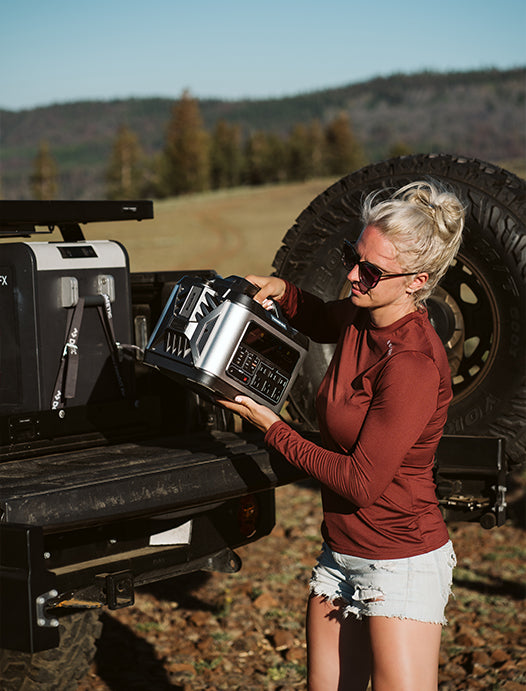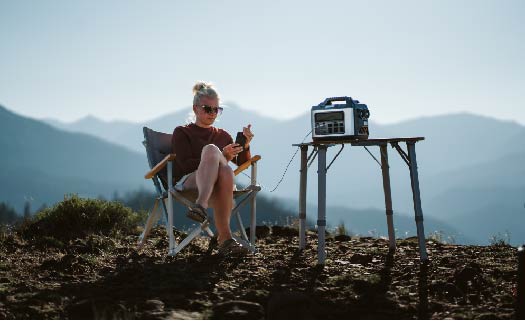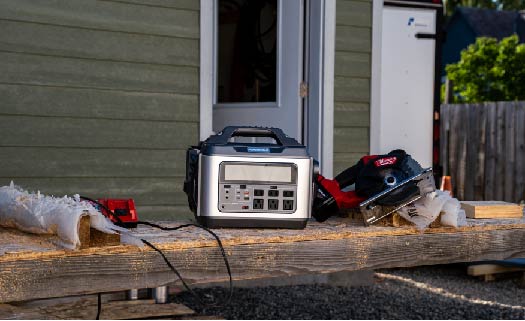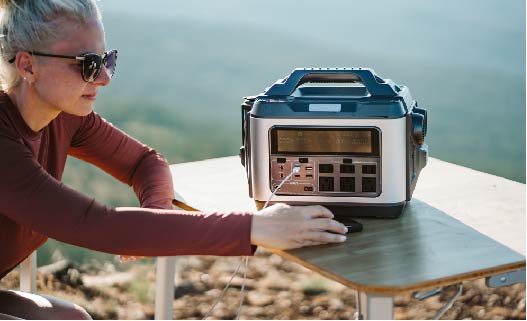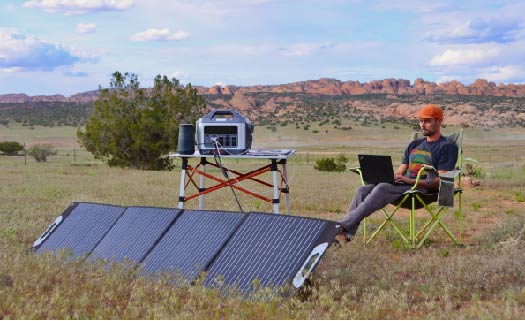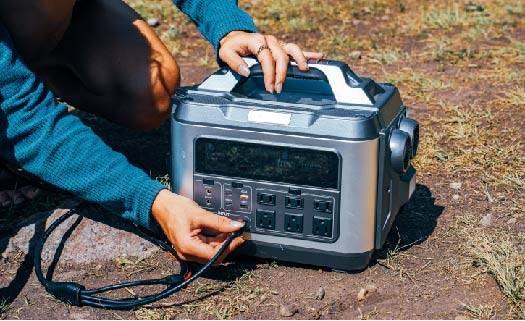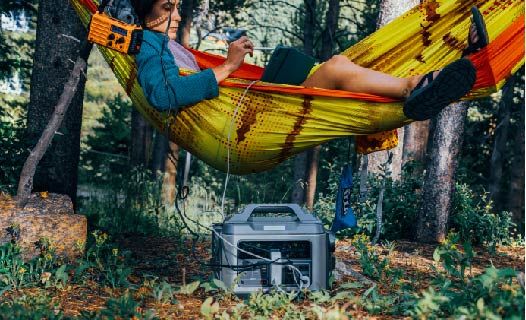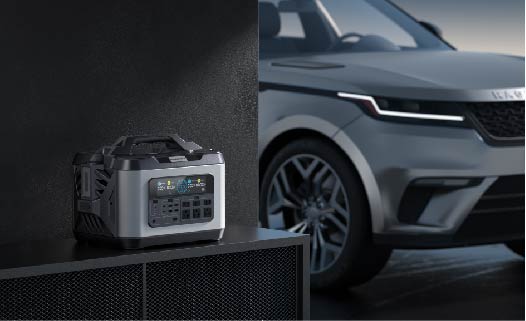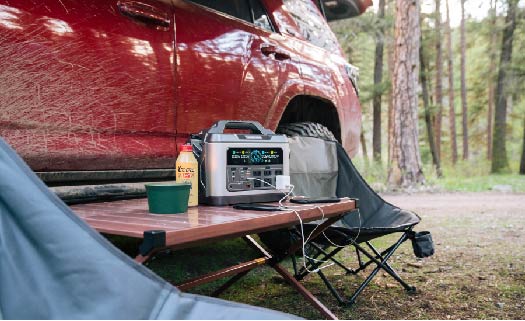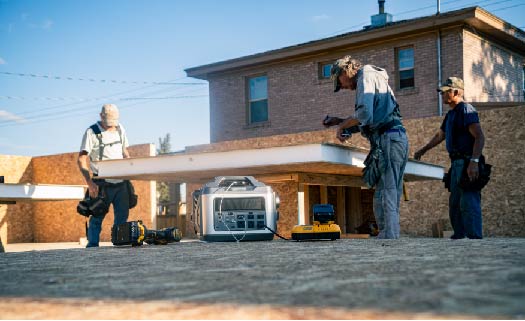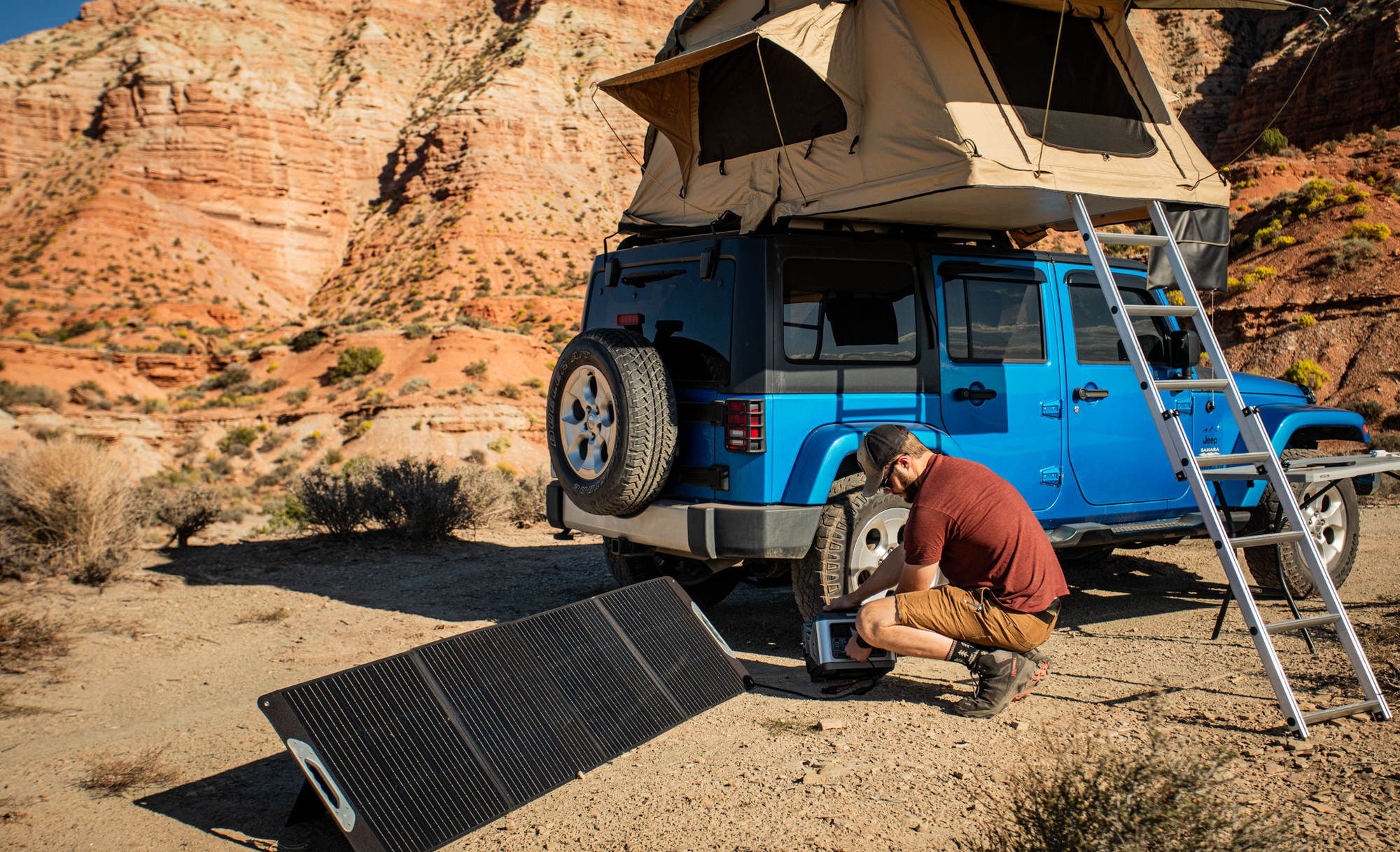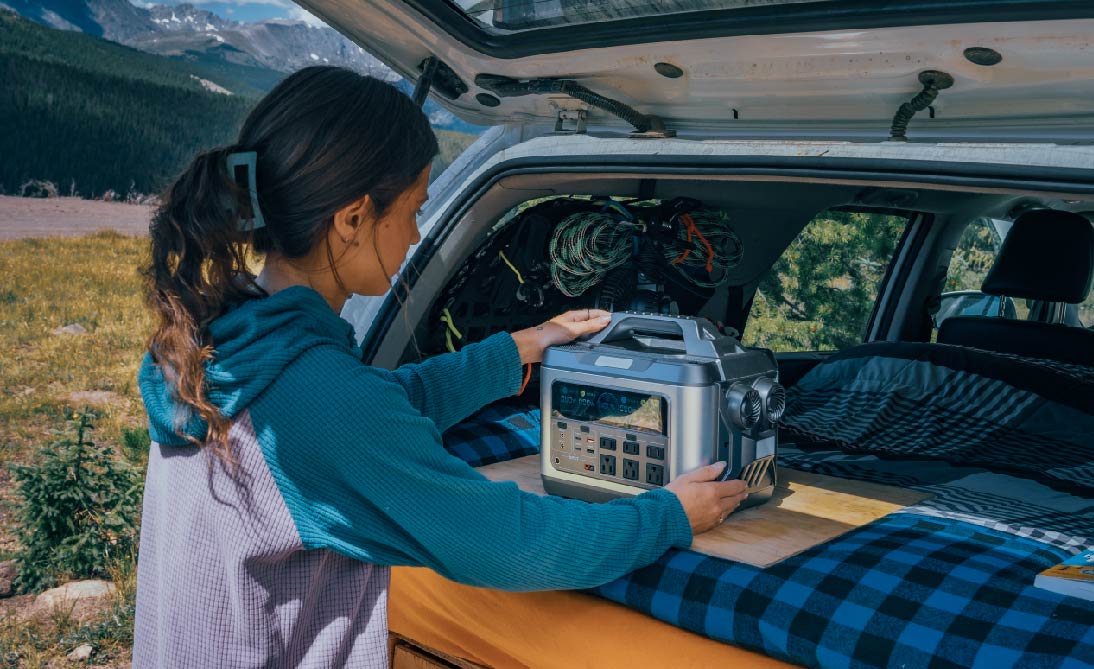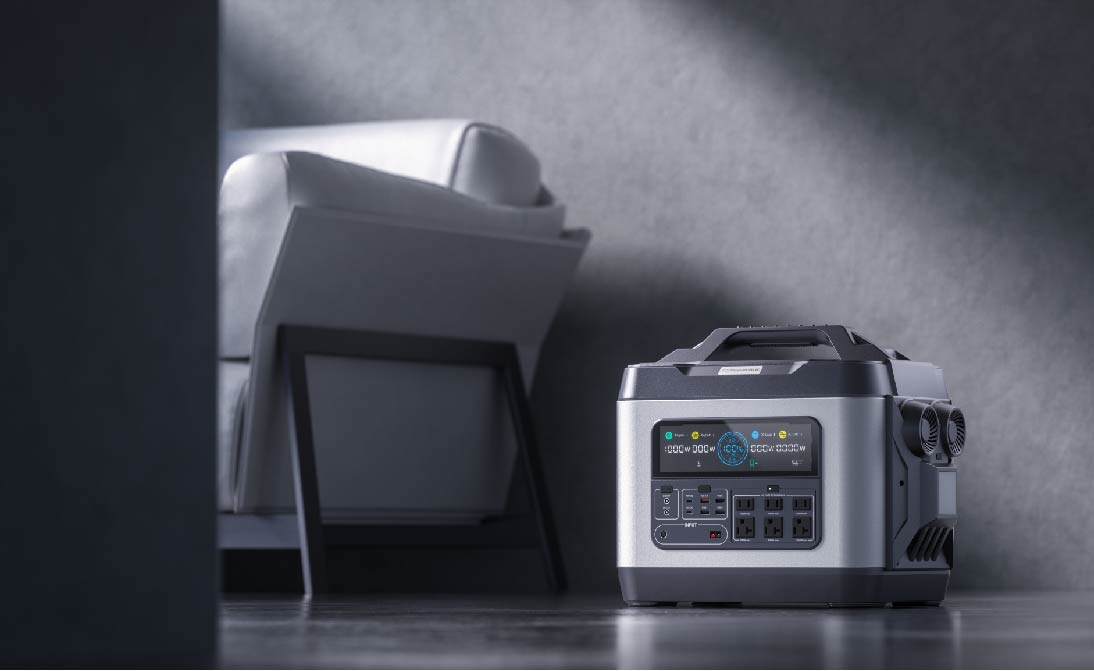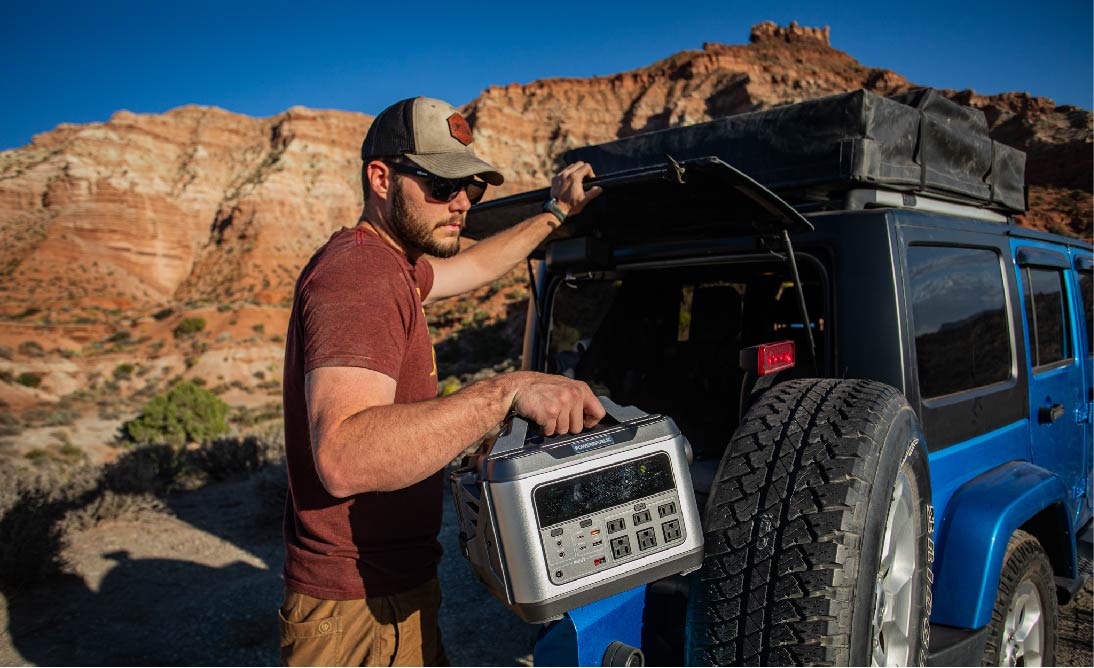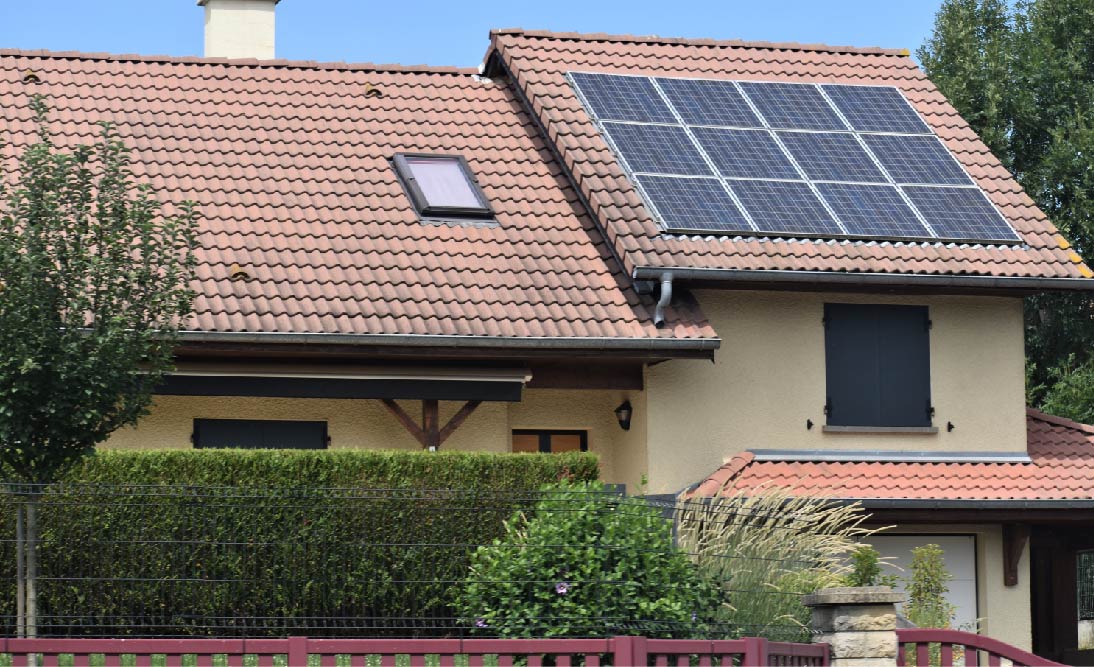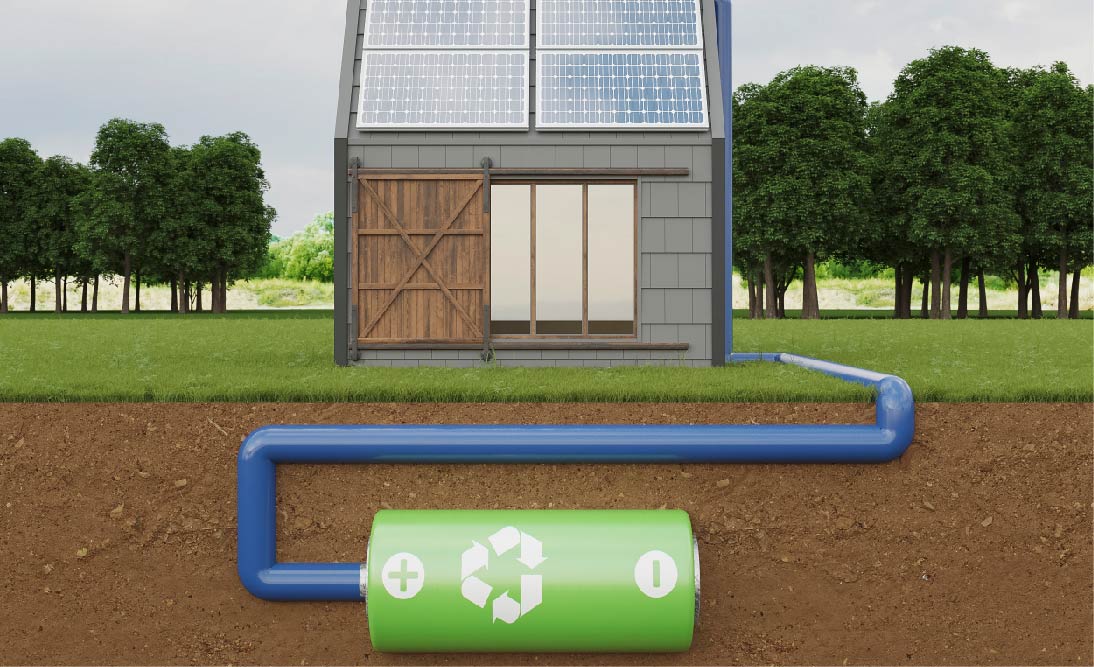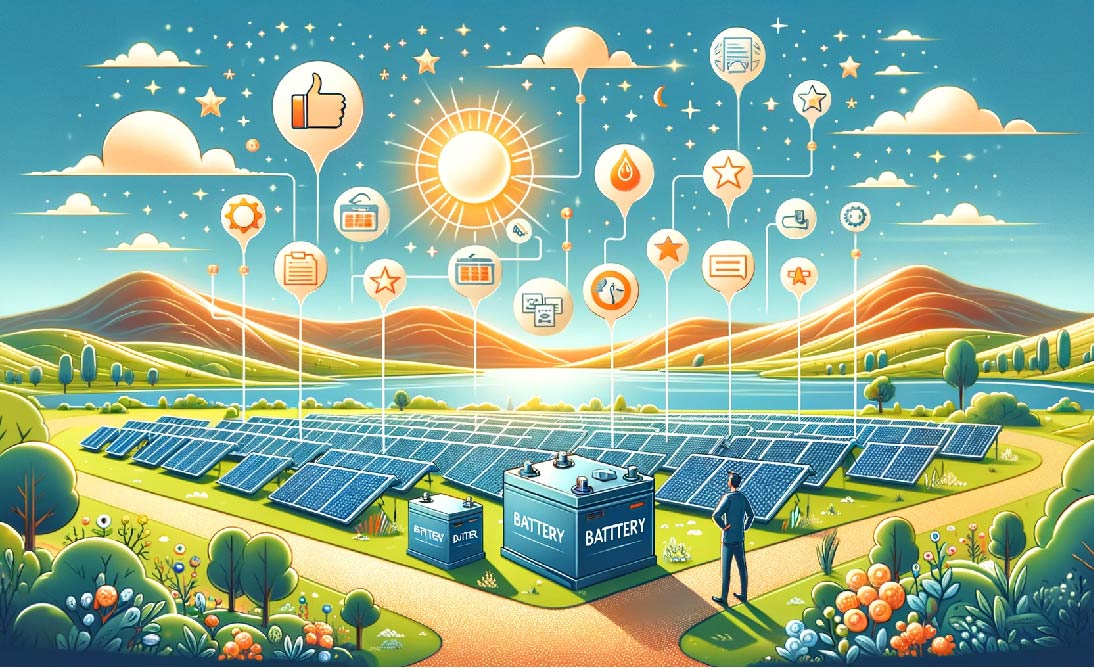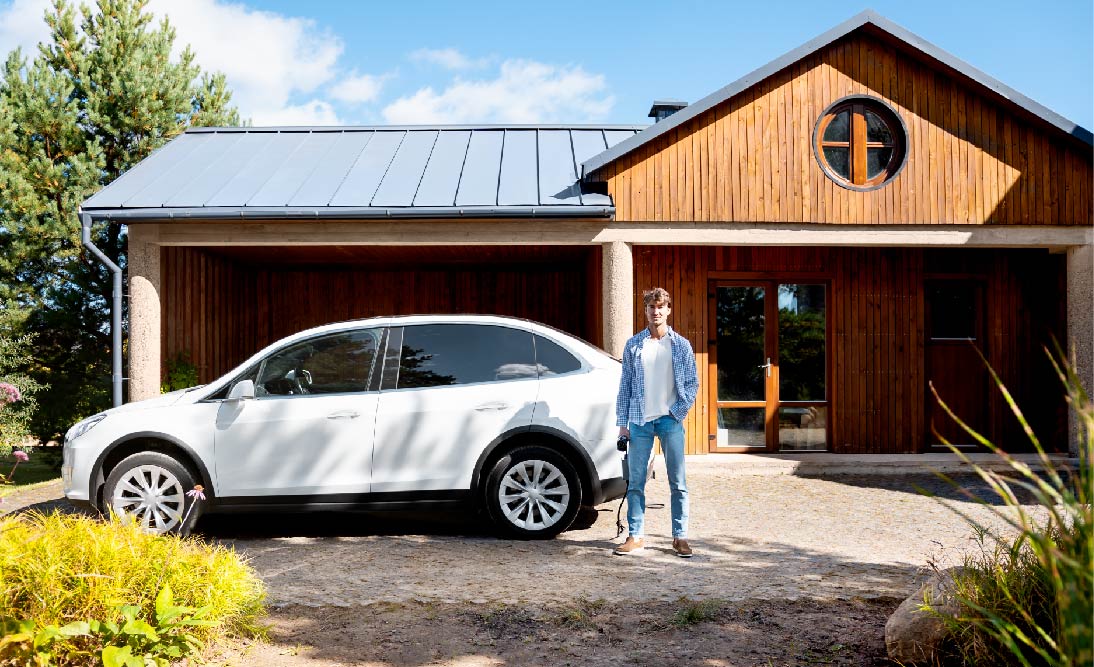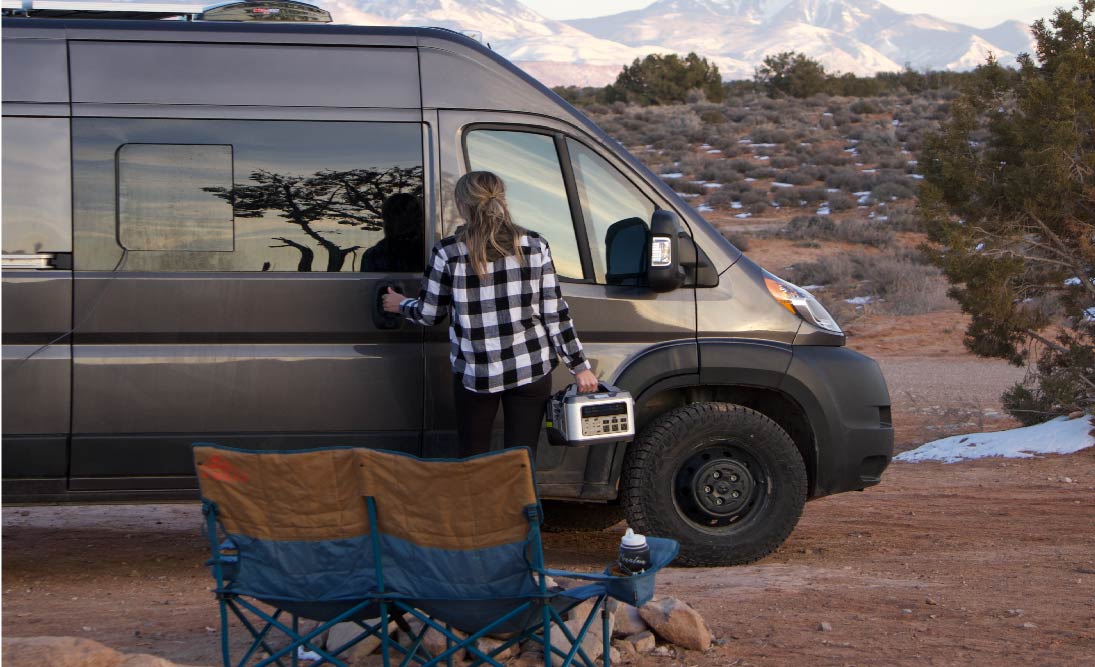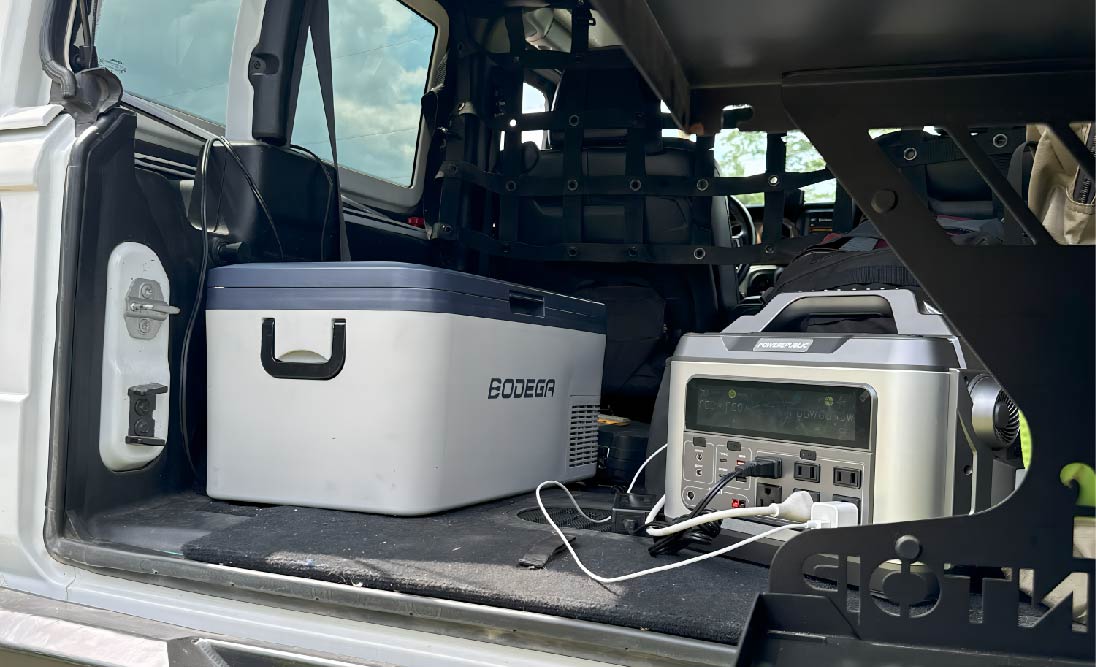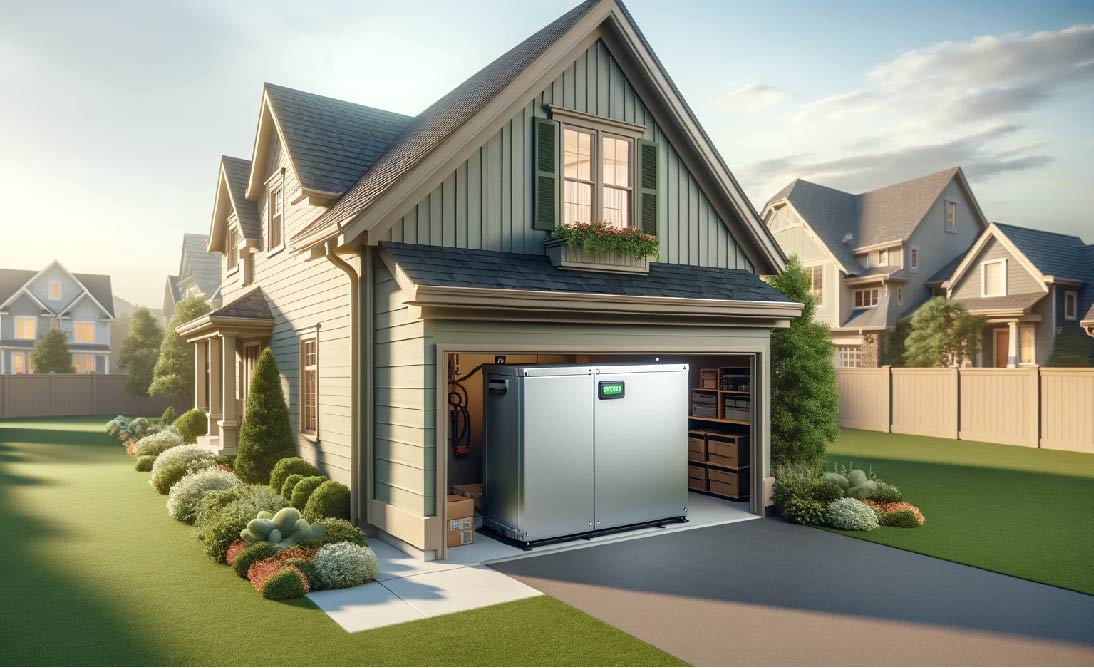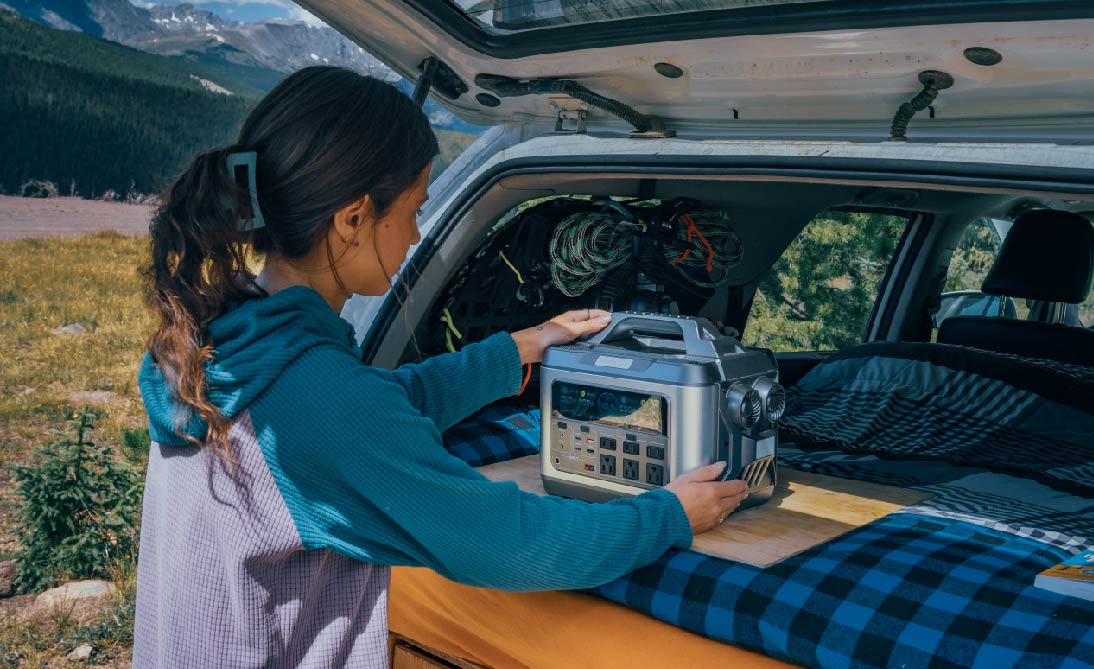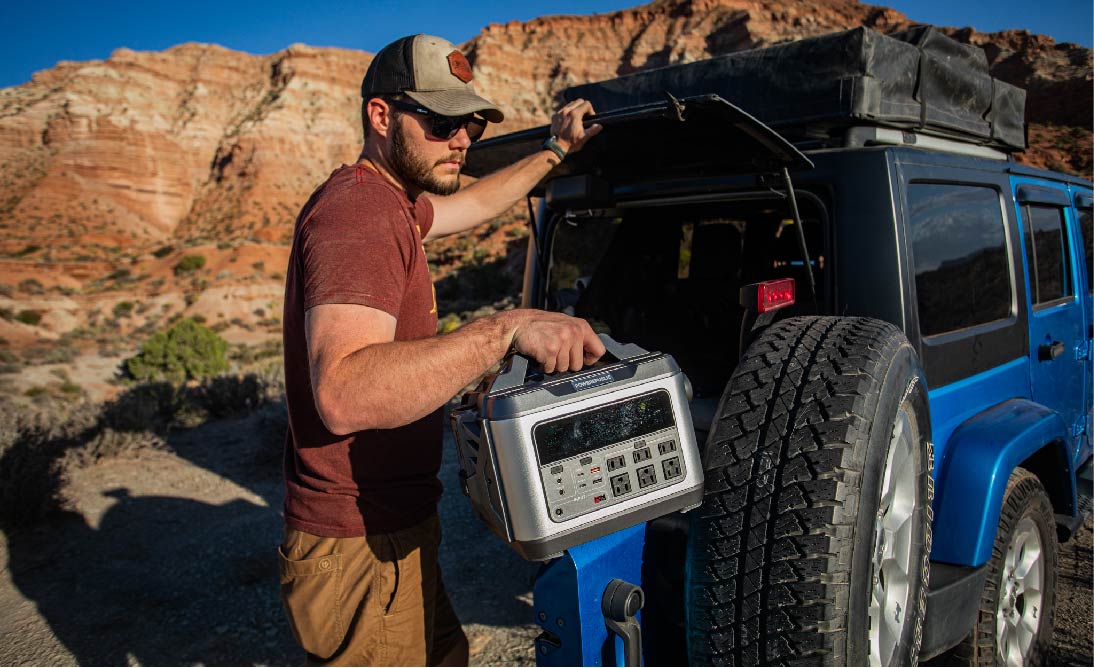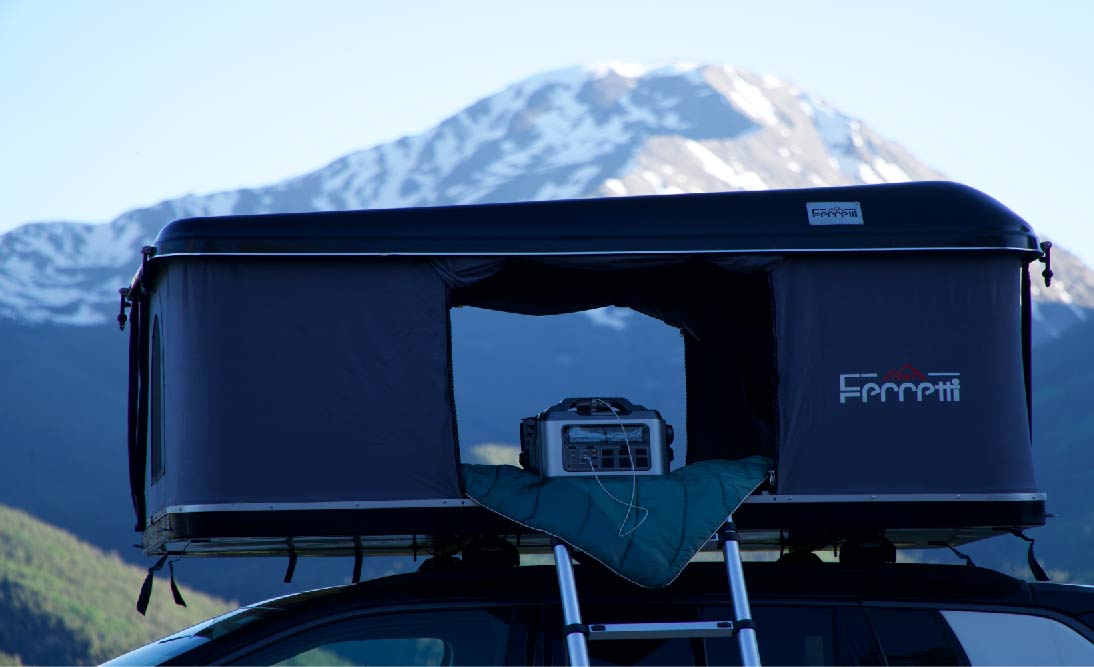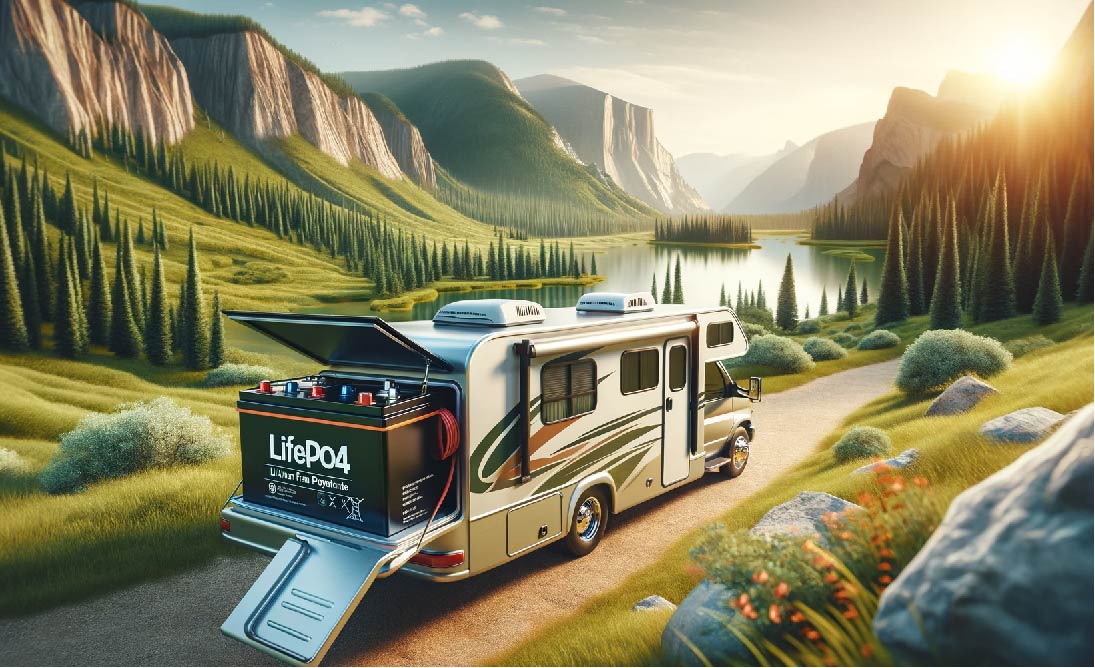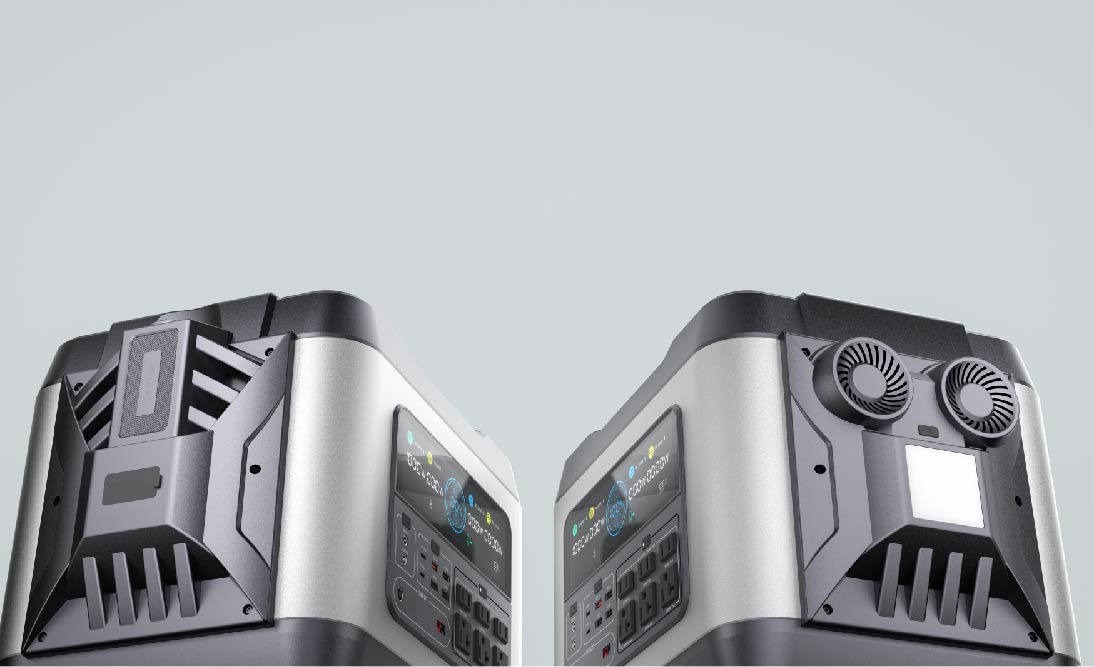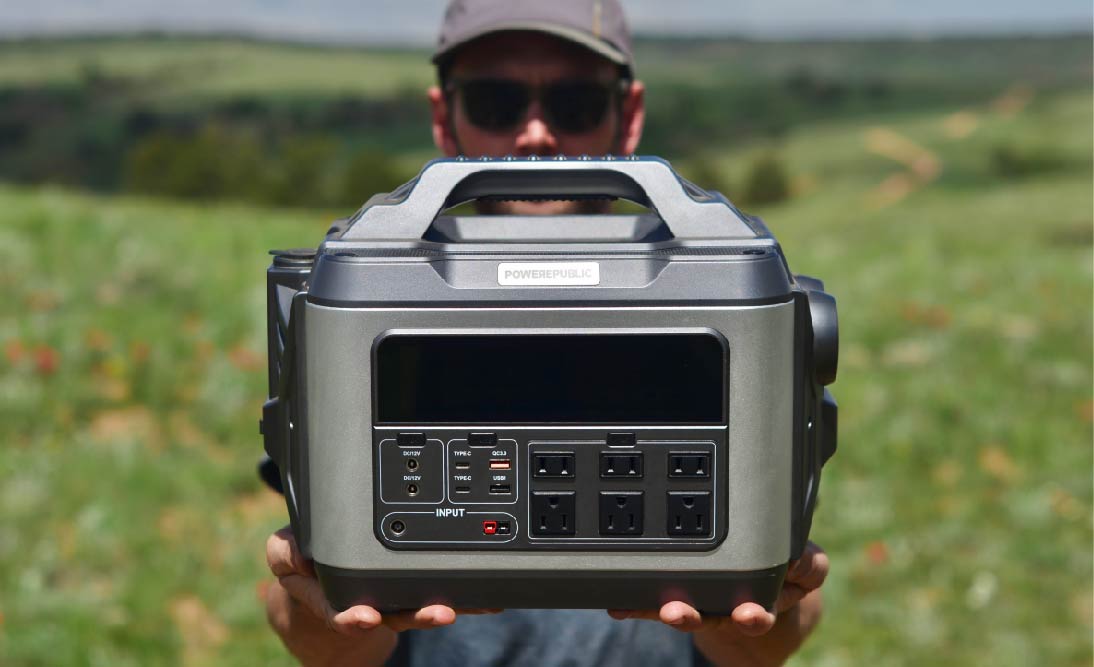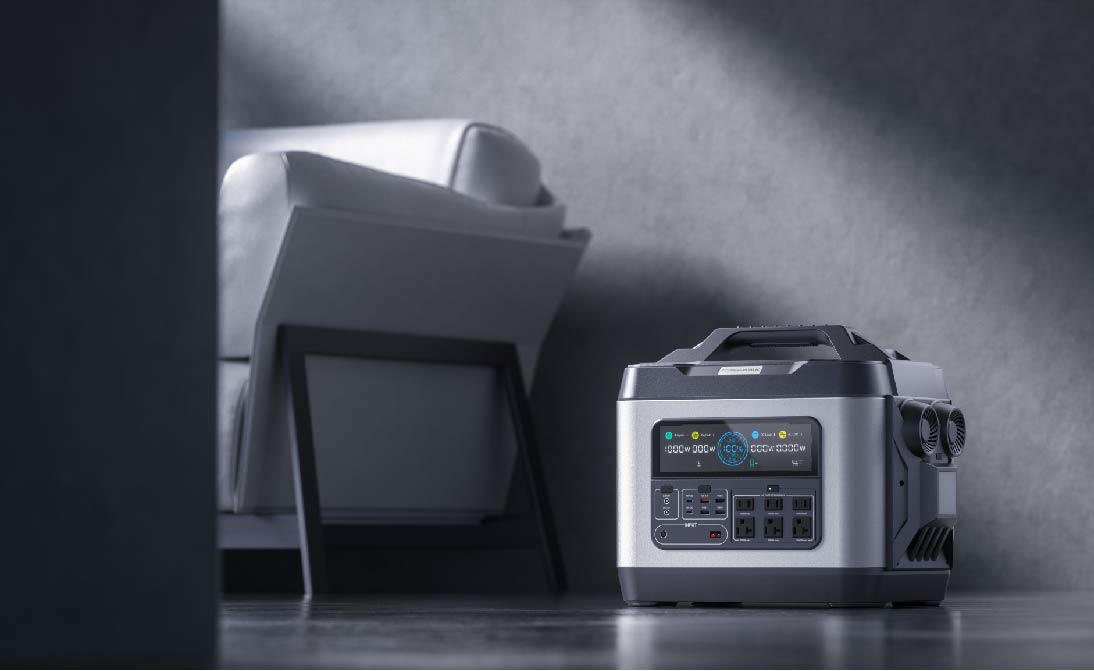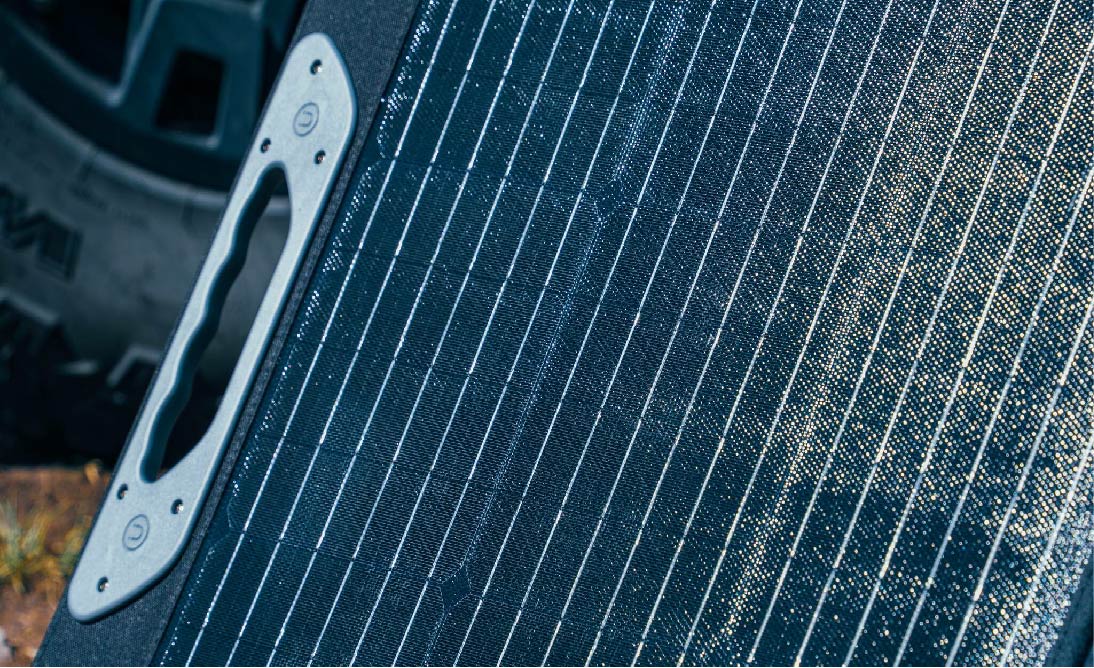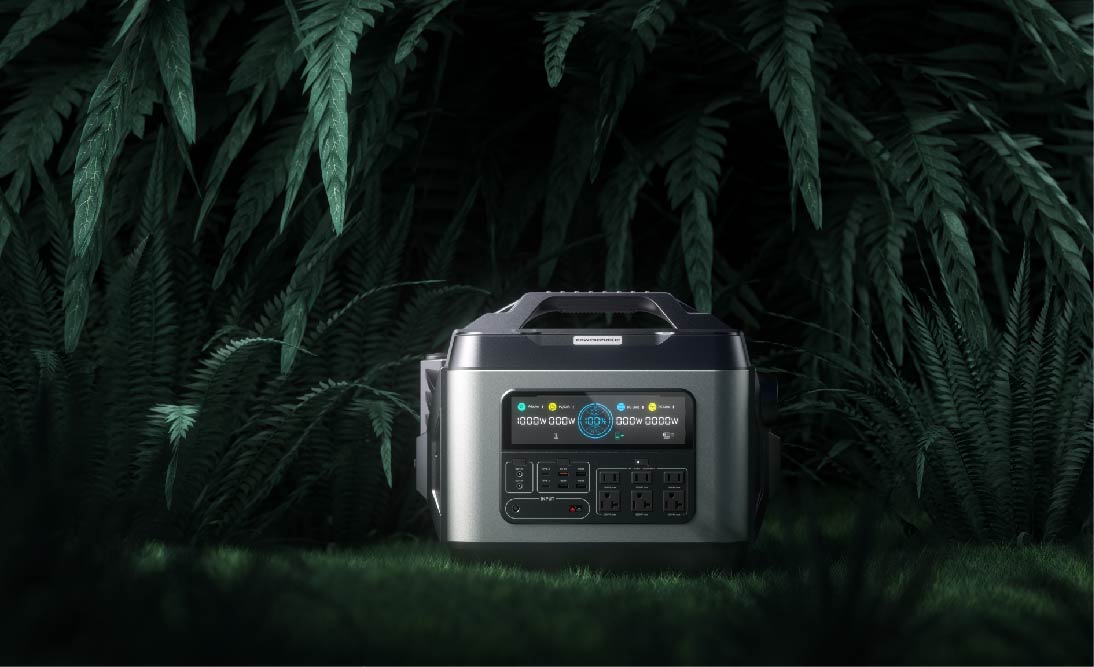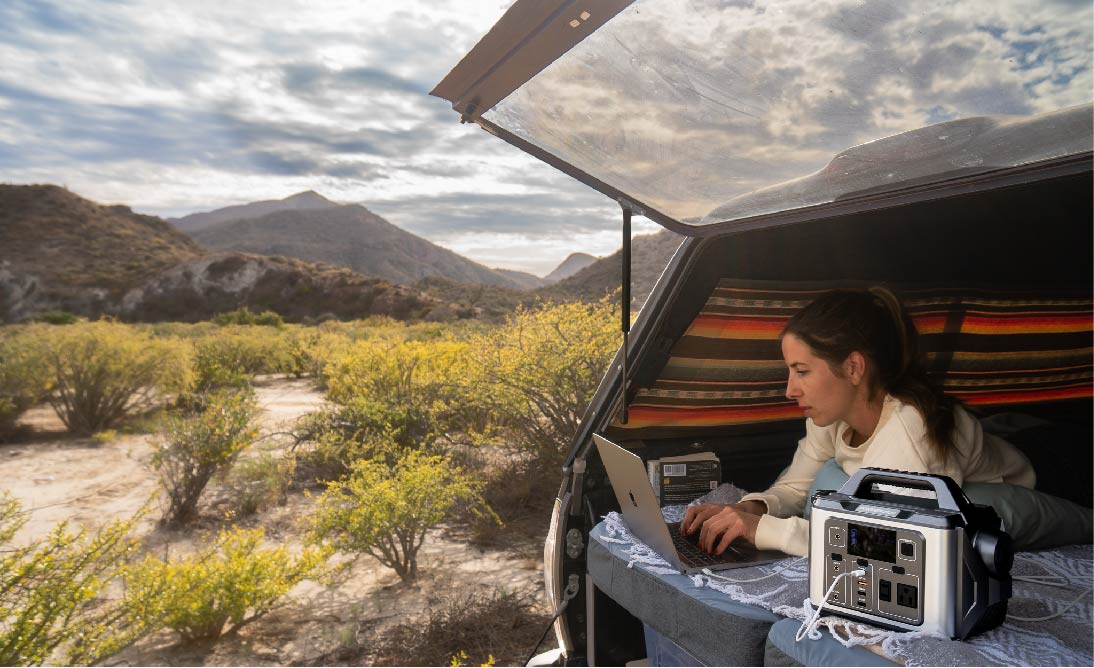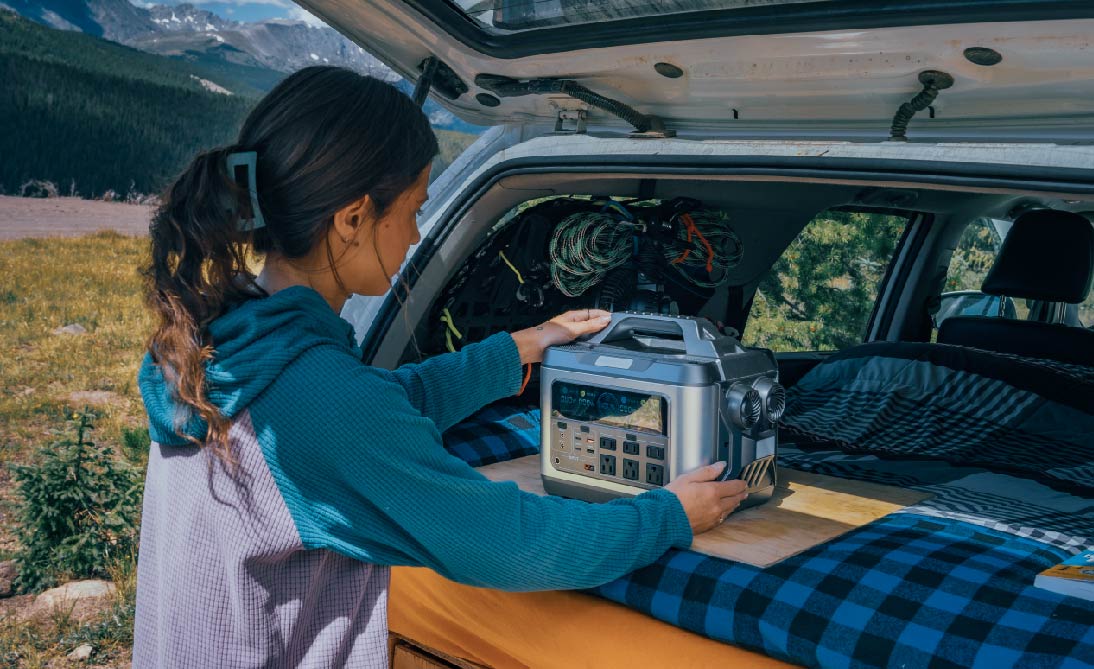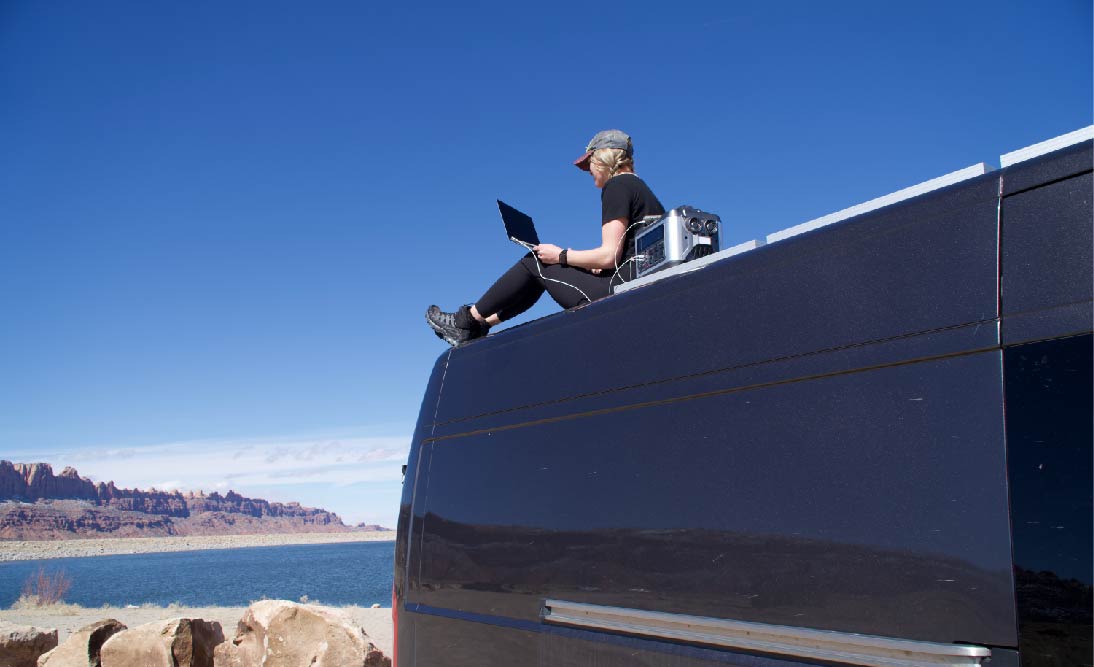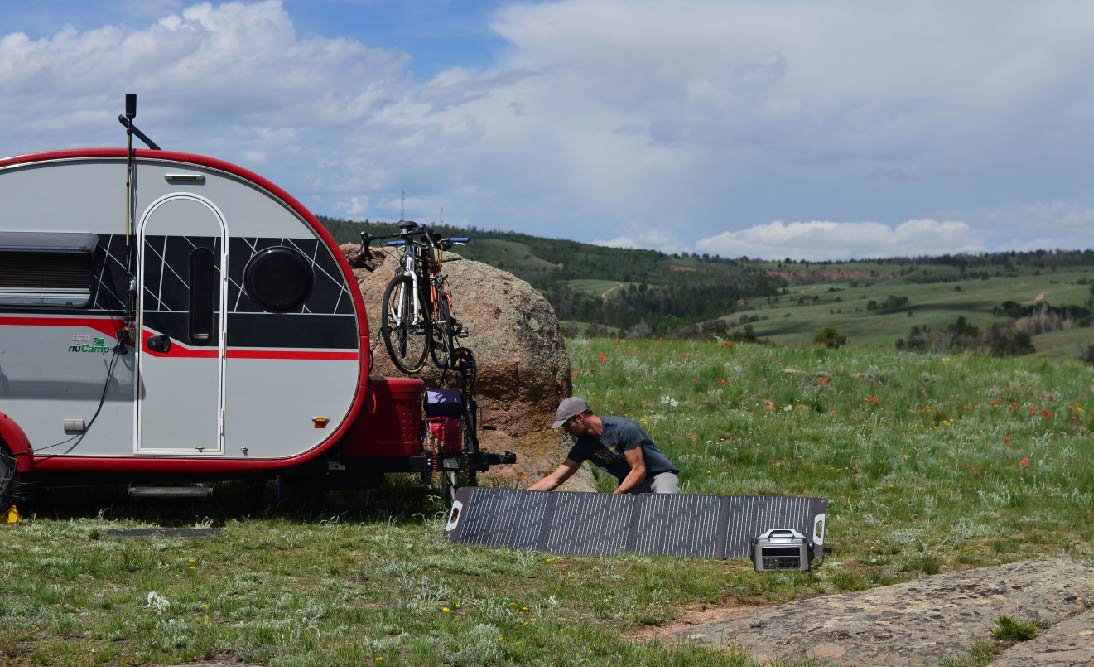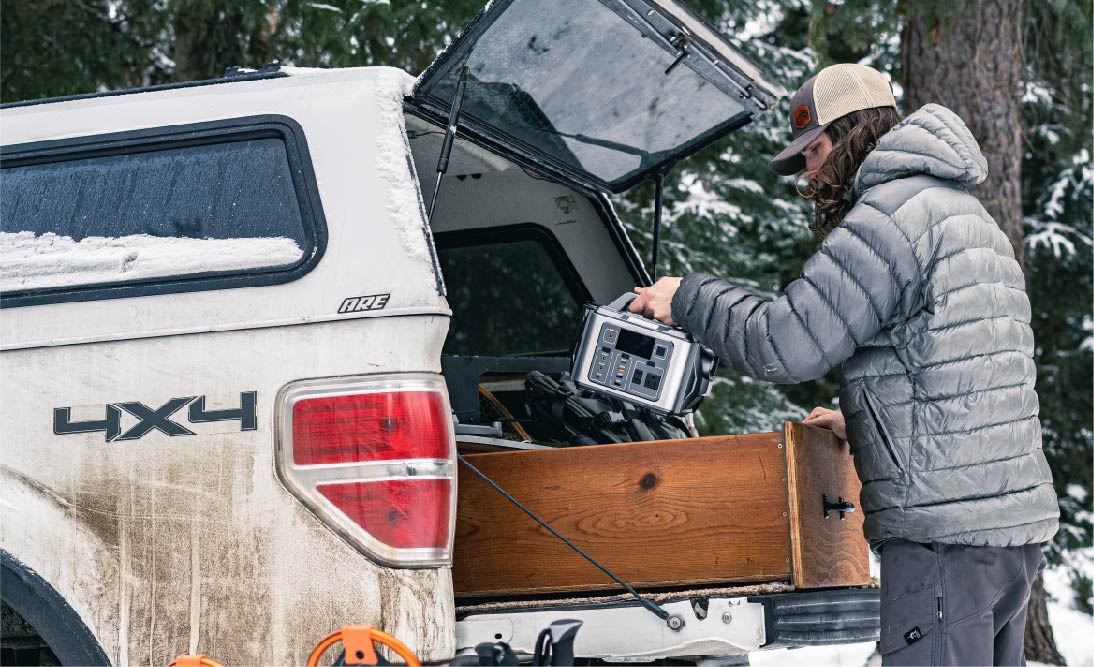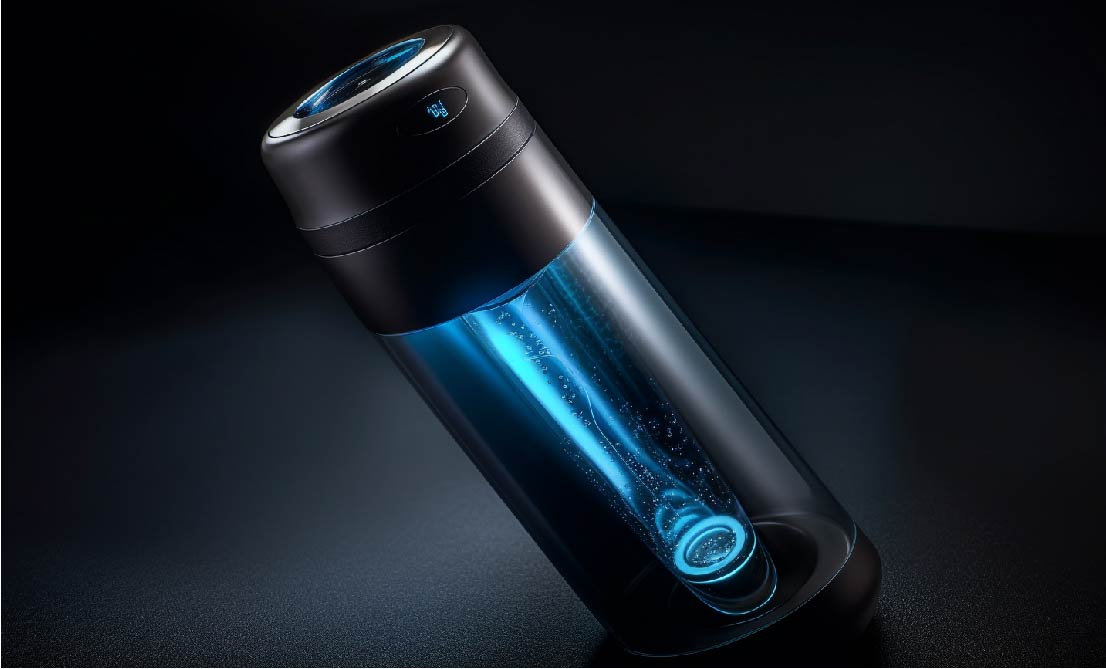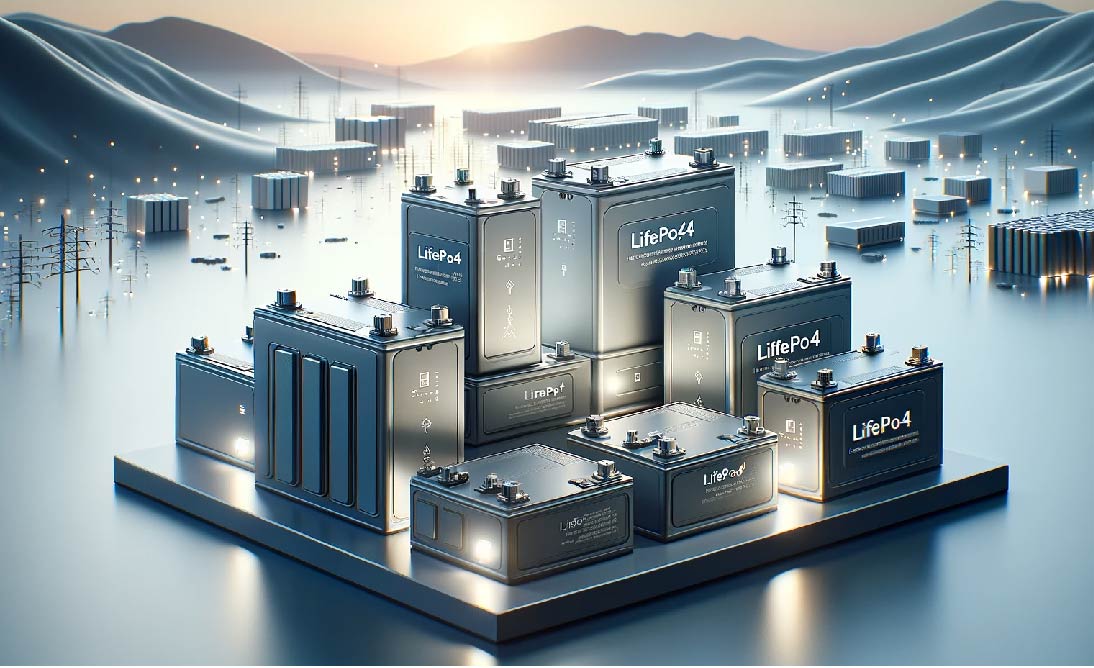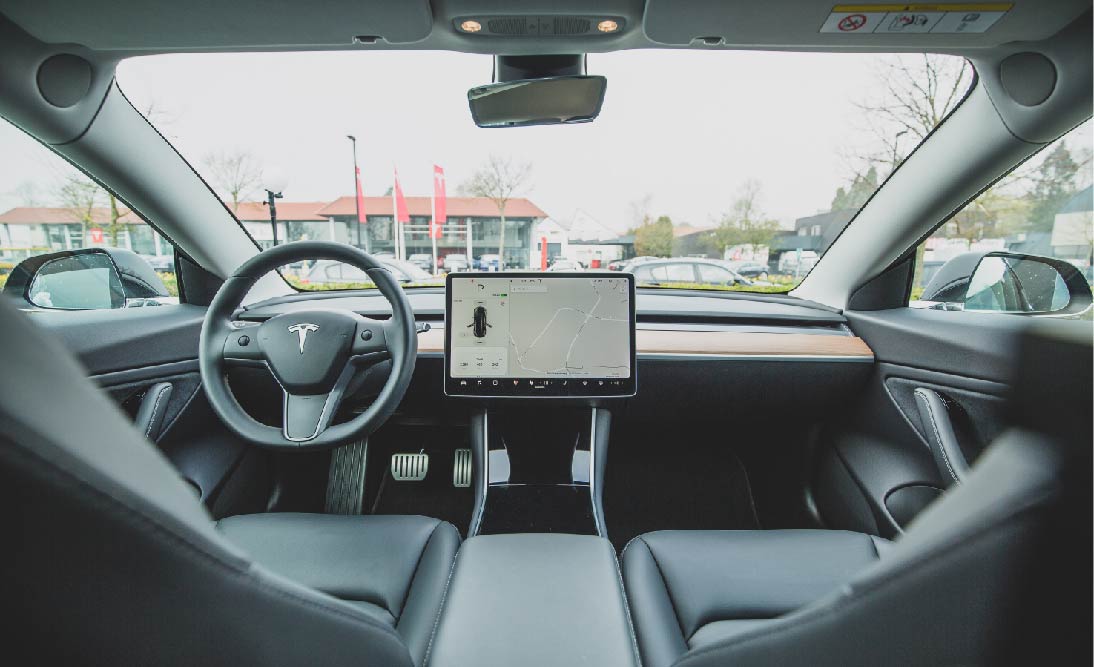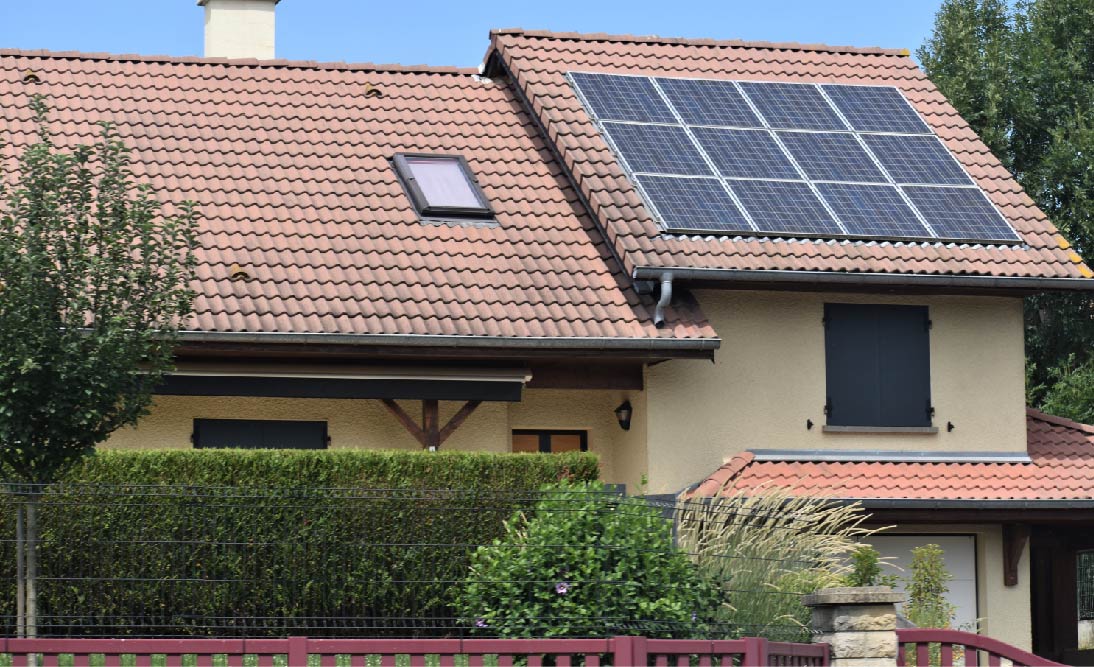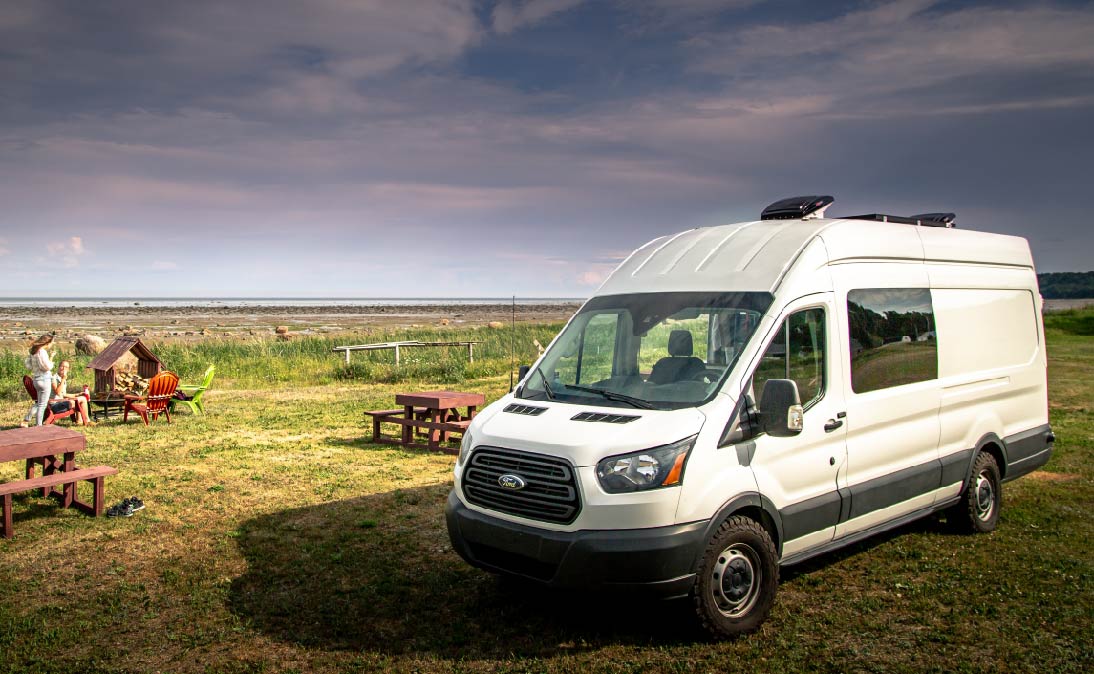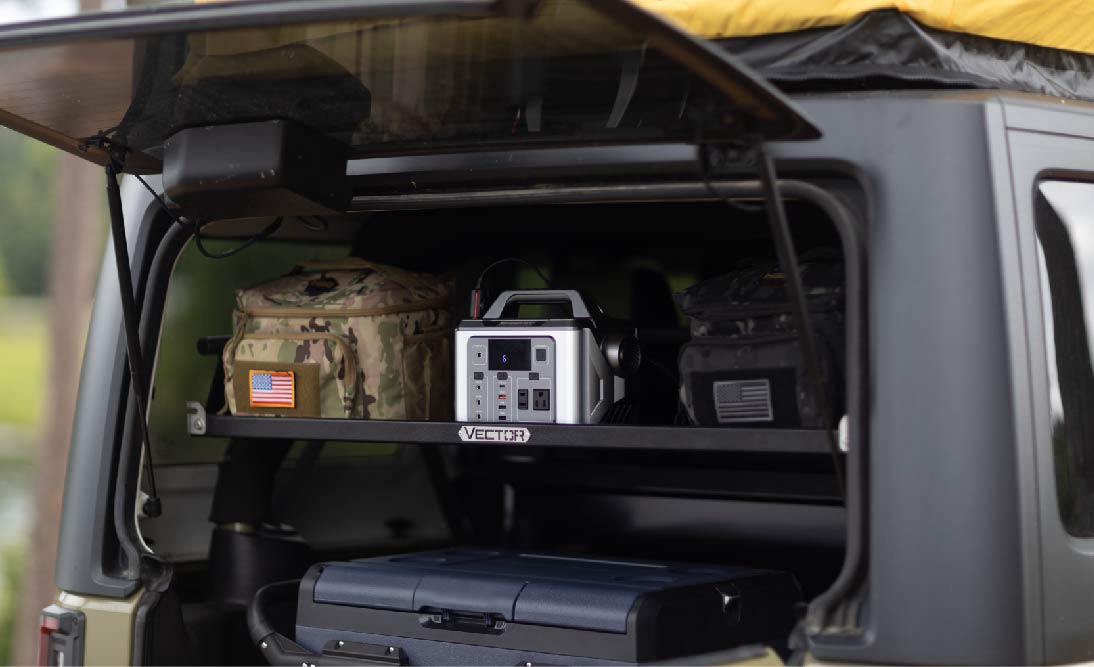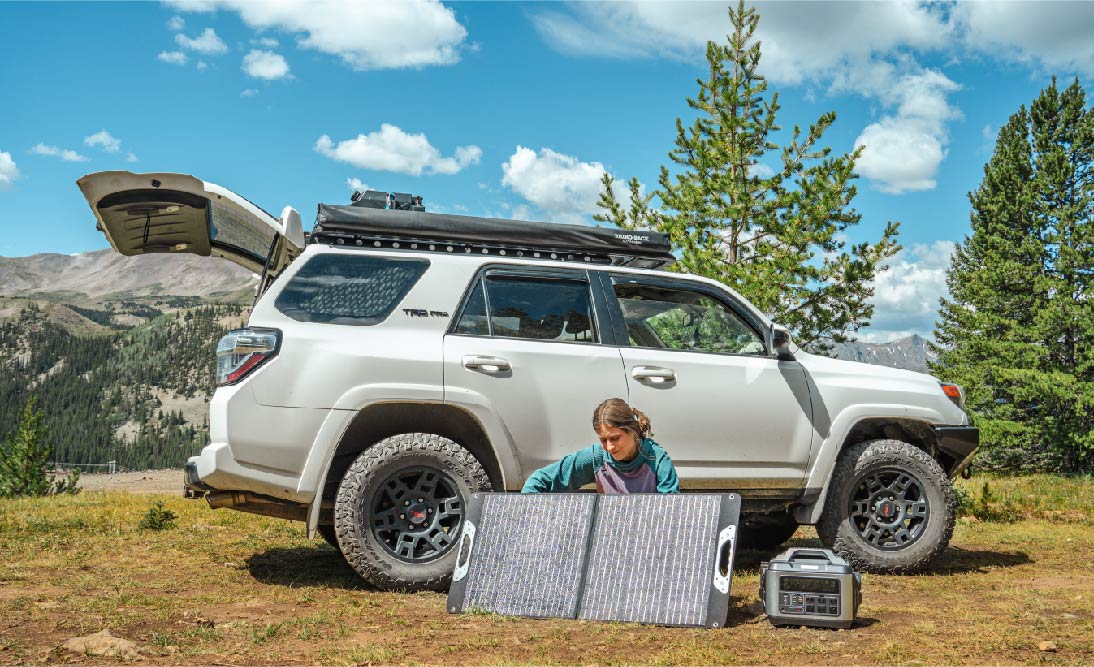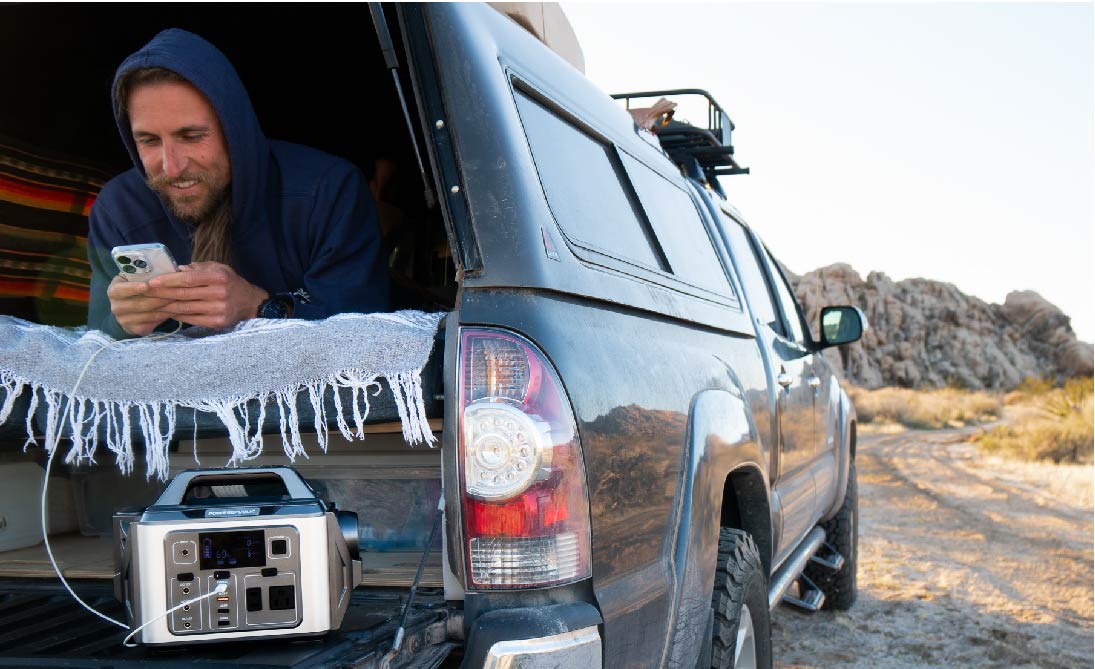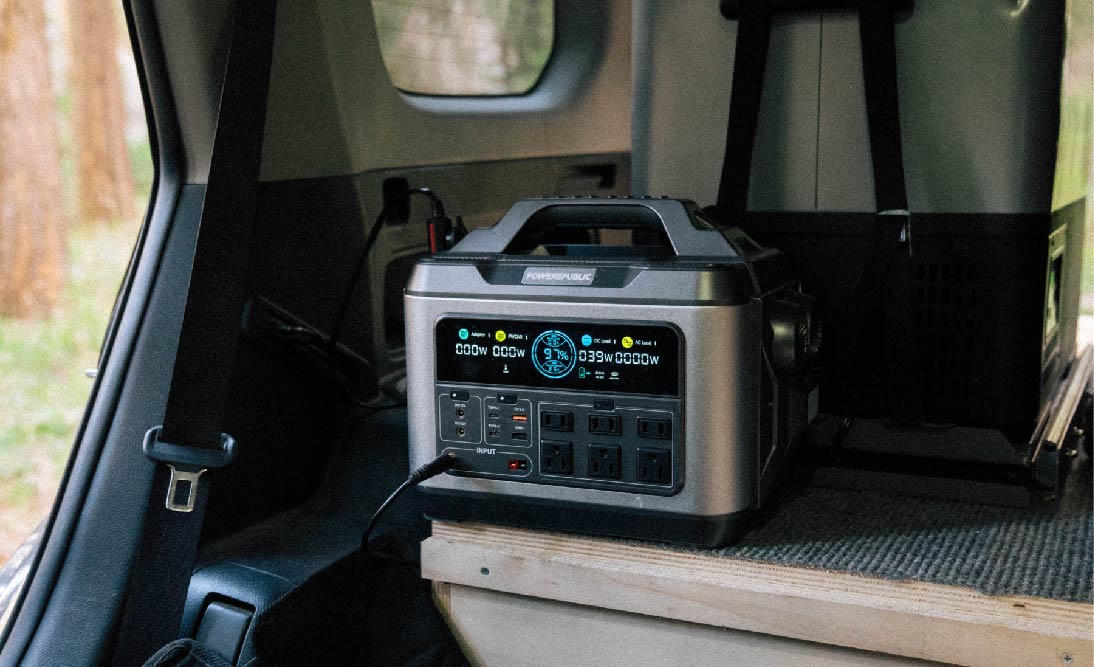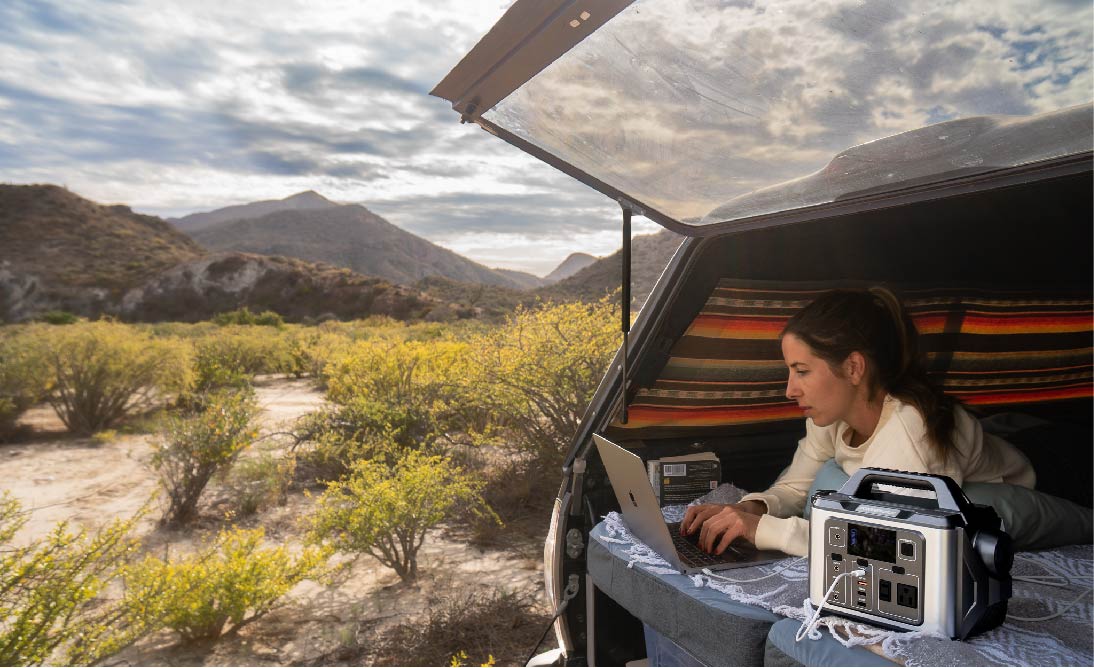Table Of Contents:
For mobile power, nothing beats a portable power station. These gadgets are getting more and more popular for storing emergency power and are super handy when you're out camping. Portable power stations come in all sorts of sizes and power levels, and there are plenty of choices available.
When you're shopping for one, start by asking yourself, 'What size portable power station is suitable for me?' Then, you can make your buying choices from there.
Understanding The “Size” by Knowing Running Power And Peak Power

Power stations are usually measured in watts (W), which is a way to figure out how fast they can give you energy. Simply put, the more watts a power station has, the more energy it can give you in one go.
Now, there are two important watt measurements to keep in mind when picking a power station:
Running Power: This tells you how much steady power a power station can provide over time. Running power can be also referred to as running watt.
Peak Power: This is the most power it can give you in a quick burst. Peak power can be also referred to as surge power, starting power, or starting watt.
Let's break it down with an example. When you turn on your air conditioner, it needs a big burst of power to start up – that's the peak power. But to keep running, it needs less power, which is the continuous power.
Some things, like fridges, need 3-7 times more power when they start. So, your power station must handle this peak power to run the appliance. If you're using a solar generator for a fridge, it's not enough to just match the continuous power requirement.
Most of the time, continuous power is the important number to focus on. It tells you how much energy you'll get from one charge of your power station under normal conditions
4 Steps To Figure Out The Total Power You Need
Step 1: Identify the Devices You Want to Power
The first and most crucial step in finding the right portable power station is to understand your power needs. Begin by making a list of the specific devices you intend to power and estimating how long you'll need them to run.
For outdoor enthusiasts, this might entail charging devices like cell phones, laptops, or even drones. On the other hand, if you're living in a van or a similar setup, you might need to power devices with higher energy demands, such as hair dryers, heaters, microwaves, or electric grills.
Step 2: Calculate Your Total Energy Requirements (in Wh)
Once you've determined which devices you want to power, it's time to quantify your total energy needs, typically measured in watt-hours (Wh). To do this, check the wattage rating of each of your devices. If you only have information on amps (A) and voltage (V), you can calculate wattage by multiplying these two values together.
Let's take an example:
Suppose you plan to power a 60-watt TV for two hours. Here's how you calculate the total watt-hours required:
-
Running time: 2 hours
-
Wattage of TV: 60W
-
Total watt-hours: 60W * 2 hours = 120Wh
-
Power Station Battery Capacity: 120Wh / 0.85 (conversion rate) = 141.18Wh (rounded up to 142Wh)
Therefore, you'd need a portable power station with a battery capacity of at least 142Wh to sustain a 60W TV for 2 continuous hours.
Step 3: Combine the Watt-Hour Requirements for All Devices
Continuing with the above approach, perform the same calculation for each of the devices on your list. Then, add up all the watt-hour values to determine the total watt-hours required from your portable power station. For instance, if your needs include 300Wh for the TV, 300Wh for laptops, and 200Wh for drones, your overall requirement would be 800Wh.
Step 4: Select the Right-Sized Power Station
With your total watt-hour requirement from Step 3 in mind, you can now proceed to choose the appropriately sized portable power station. Look for one with a capacity that exceeds your total requirement. In this case, a power station with at least 942Wh (calculated as 800Wh / 0.85 = 941.18Wh) would ensure it can handle all your devices effectively.
Following these steps will not only help you identify the right portable power station but also ensure you make an informed choice that meets your specific energy needs.
POWEREPUBLUC Portable Power Station For Various Situations
Running out of power is always a hassle. That's why POWEREPUBLIC has developed various solar generators with different sizes and power capacities. Whether you're seeking a backup solution for your home or a portable power source for outdoor activities, Let POWEREPUBLIC back you up.
Car Camping/Overlanding

Whether you're going on a car camping trip, setting up a tent in the wilderness, or just need a reliable portable power source, POWEREPUBLIC has you covered.
The T306 and T1200 are dependable options to keep your small gadgets charged while you're on the move. This ensures you stay connected and powered up throughout your adventure. Whether you're using your smartphone to capture beautiful moments, brightening up your campsite with lights, or playing music with speakers, the T306 and T1200 have got you covered.
If you only need to charge essential devices like phones, laptops, GPS devices, and cameras, then the T306 is the right choice for you. It has 300W power (can surge up to 600W), a 296Wh capacity, and weighs less than 10 pounds, making it the perfect companion.
If you want to power not only your essentials but also larger items for an extended period, go for the POWEREPUBLIC T1200(1200W/1110Wh, surge 2600W). In addition to charging your essential devices, it can also power items like blenders, coffee machines, electric grills, TVs, mini-fridges, and mini-coolers.
Here's a table showing some common devices used during car camping and how long the T306 and T1200 can power them:
|
Devices & Appliances |
Rated Power |
Working Time: T306 |
Working Time: T1200 |
|
Smartphones |
5-10W |
25 - 50 hours |
94 - 188 hours |
|
Laptops |
30-60W |
4 - 8 hours |
15 - 31 hours |
|
GPS Devices |
5W |
50 hours |
188 hours |
|
Coffee Machines |
600W - 1200W |
Not Suitable |
0.7 - 1.5 hours |
|
Blenders |
400W - 1000W |
Not Suitable |
1 - 2 hours |
|
Electric Grills |
1000W - 1200W |
Not Suitable |
Less than 1 hour |
|
LED TVs |
50W - 150W |
1 - 5 hours |
6 - 18 hours |
|
Mini-Fridges |
50W -100W |
2 - 5 hours |
9 - 18 hours |
|
Mini-Coolers |
40W-60W |
4 - 6 hours |
15 - 23 hours |
|
DSLR Cameras |
10W -20W |
12 - 25 hours |
47 - 94 hours |
Van-life/RV-life/Trailers

Most vans and RVs come with built-in solar systems for power, but having a backup battery is smart for emergencies and cloudy days. POWEREPUBLIC offers the T1200 and T2200, great choices for a more comfortable off-grid experience.
Both have 6 AC outlets, 2 DC/12V Ports, and a car charger, allowing you to charge multiple devices at once. You can also recharge them on the go with a 200W portable solar panel.
POWEREPUBLIC T1200: Rated power of 1200W, surge up to 2600W, and a battery capacity of 1110Wh. It can charge most van appliances like hairdryers, water heaters, microwaves, and electric grills.
POWEREPUBLIC T2200: Rated power of 2200W, surge up to 4500W, and a battery capacity of 2220Wh. It's perfect for running those appliances for a longer time.
Here's a summary of what our T1200 and T2200 can do:
|
Devices & Appliances |
Rated Power |
Working Time: T1200 |
Working Time: T2200 |
|
Refrigerators |
100W - 200W |
4 - 9 hours |
9 - 18 hours |
|
Air Conditioners |
1000W - 2000W |
Less than 1 hour |
1 - 2 hours |
|
Microwaves |
600W - 1200W |
0.5 - 1.5 hours |
1.5 - 3 hours |
|
Water Heaters |
1200W -1400W |
Less than 1 hour |
1.3 - 1.5 hours |
|
TVs |
50W- 150W |
6 - 18 hours |
12 - 37 hours |
|
Ventilation Fans |
15W - 60W |
15 - 62 hours |
31 - 125 hours |
|
Coffee Makers |
600W - 1200W |
0.5 - 1.5 hours |
1.5 - 3 hours |
|
Toasters |
800W -1500W |
0.5 - 1 hour |
1.2 - 2.3 hours |
|
Hair Dryers |
1200W - 1800W |
Less than 1 hour |
1 - 1.5 hours |
|
Electric Kettles |
1000W - 1500W |
Less than 1 hour |
1.2 - 1.8 hours |
Off-Gird Living

Off-grid systems can be complex and less portable. That's why you need portable power stations that offer high power and big batteries. Enter POWEREPUBLIC T2200 and T3000, designed to power 95% of your home or outdoor devices.
POWEREPUBLIC T2200: With 2200W rated power (surges up to 4500W) and a 2240Wh battery, it can charge nearly all your home and outdoor appliances. It's a versatile power source for both indoor and outdoor needs.
POWEREPUBLIC T3000: Boasting 3000W rated power (surges up to 6000W) and a 3290Wh battery, it's perfect for running home appliances and serving as a dependable backup battery, especially in areas with extreme weather.
These portable power stations offer robust solutions for various power needs, whether you're at home or in the great outdoors.
The table below shows how powerful our T2200 and T3000 are:
|
Devices & Appliances |
Rated Power |
Working Time: T2200 |
Working Time: T3000 |
|
Refrigerators |
100W - 200W |
9 - 18 hours |
13 - 27 hours |
|
LED Lights |
5W - 10W |
190 - 380 hours |
272 - 544 hours |
|
Ventilation Fans |
15W - 60W |
31 - 125 hours |
45 - 181 hours |
|
Water Pumps |
200W - 500W |
3 - 9 hours |
5 - 13.5 hours |
|
CPAPs |
30W - 300W |
6 - 62 hours |
9 - 90 hours |
|
Space Heaters |
1500W -2500W |
0.5 - 1.2 hours |
1 - 2 hours |
|
Air Conditioners |
1000W - 3500W |
0.5 - 2 hours |
0.5 - 2.7 hours |
|
Washing Machines |
500W - 2000W |
1 - 3.5 hours |
1 - 5 hours |
|
Coffee Makers |
600W -1200W |
1.5 - 3 hours |
2 - 4.5 hours |
|
Microwaves |
600W - 1200W |
1.5 - 3 hours |
2 - 4.5 hours |
Power Outages

Home appliances like refrigerators are essential appliances that need power to keep all your food frozen and fresh, especially during outages. POWEREPUBLIC T2200 and T3000 are here to keep your fridge and other home devices running when the lights go out.
POWEREPUBLIC T2200: With 2200W rated power (surging up to 4500W) and a 2240Wh battery, it can power most of your home and outdoor gadgets. It's a versatile solution for outages and emergencies.
POWEREPUBLIC T3000: Packing a punch with 3000W rated power (surging up to 6000W) and a 3290Wh battery, it's perfect for running your home appliances and acting as a reliable backup during power interruptions.
These portable power stations ensure that you don't lose your fridge's cool, even when the grid goes dark.
The table shows the versatility and functionality of the T2200 and T3000:
|
Devices & Appliances |
Rated Power |
Working Time: T2200 |
Working Time: T3000 |
|
Refrigerators |
100W - 200W |
9 - 18 hours |
13 - 27 hours |
|
Routers |
10W -30W |
63 - 190 hours |
90 - 272 hours |
|
CPAP |
30W - 300W |
6 - 62 hours |
9 - 90 hours |
|
Freezers |
100W - 800W |
2 - 19 hours |
3 - 27 hours |
|
Water Pumps |
200W - 500W |
3 - 9 hours |
5 - 13.5 hours |
|
Space Heaters |
1500W -2500W |
0.5 - 1.2 hours |
1 - 2 hours |
|
Coffee Makers |
600W -1200W |
1.5 - 3 hours |
2 - 4.5 hours |
|
Microwaves |
600W - 1200W |
1.5 - 3 hours |
2 - 4.5 hours |
|
TVs |
50W- 150W |
12 - 38 hours |
18 - 54 hours |
|
Sump Pumps |
600W -750W |
2 - 3 hours |
3 - 4.5 hours |
Remote Working

Remote work is increasingly popular, and it often involves various devices and tools, including power drills, circular saws, and edgers, which require a lot of power. That's where POWEREPUBLIC T1200 and T2200 portable power stations come in handy.
These power stations have larger battery capacities and can deliver a surge power output of nearly 6000 watts, making them perfect for efficiently powering high-energy tools.
POWEREPUBLIC T1200: It has a rated power of 1200W, with surges up to 2600W, and a battery capacity of 1110Wh. This means it can charge heavy-duty tools as well as your essential devices.
POWEREPUBLIC T2200: With 2200W rated power (surging up to 4500W) and a 2240Wh battery, it can keep most power tools running for an extended period. This makes them ideal for people who work remotely in wooded areas.
These portable power stations ensure that you have the energy you need to get the job done, whether you're working with tools or staying connected with your devices while working remotely in the great outdoors.
The table below shows for how long the T1200 and T2200 can power devices that are needed for remote working:
|
Devices & Appliances |
Rated Power |
Working Time: T1200 |
Working Time: T2200 |
|
Drills |
500W -1000W |
1 - 1.8 hours |
2 - 3.8 hours |
|
Circular Saws |
1200W - 1800W |
Less than 1 hour |
1 - 1.5 hours |
|
Edgers |
400W -1500W |
0.5 - 2 hours |
1 - 4.5 hours |
|
Starlinks |
50W - 150W |
6 - 18 hours |
12 - 38 hours |
|
Laptops |
30W - 60W |
15 - 31 hours |
31 - 63 hours |
|
Speakers |
30W - 100W |
9 - 31 hours |
19 - 63 hours |
|
Cellphones |
5W -10W |
94 - 188 hours |
190 - 380 hours |
Pros and Cons Of Portable Power Stations
After knowing the functionality of POWEREPUBLIC Portable Power Stations, let’s talk about some pros and cons of having one.
Pros:
1. Versatile Power Source:
Pro 1: Portable power stations can charge various outdoor gear, including smartphones, cameras, GPS devices, and laptops, ensuring you stay connected and powered up during adventures.
Pro 2: They can also run small appliances like portable fridges, camping lights, and electric stoves, adding convenience to outdoor trips.
2. Clean and Quiet Operation:
Pro 1: Portable power stations are eco-friendly and produce no emissions, making them suitable for use in environmentally sensitive areas.
Pro 2: They operate silently, preserving the tranquility of the outdoors, which is especially important for nature enthusiasts.
3. Portability:
Pro 1: These stations are designed for easy transport, featuring lightweight and compact designs. Some models include handles or carry straps for added convenience.
Pro 2: Solar-powered portable power stations allow you to recharge during the day, making them self-sufficient for extended outdoor stays.
3. Emergency Backup:
Pro 1: Portable power stations can serve as reliable emergency backup power sources during camping trips, ensuring you have essential power for communication and safety.
Pro 2: Some models offer flashlight or emergency lighting features, aiding in navigation and visibility during nighttime adventures.
4. Low Maintenance:
Pro 1: Compared to traditional generators, portable power stations require minimal maintenance. There's no need for fuel, oil changes, or engine servicing.
Pro 2: They typically have longer lifespans due to fewer moving parts that can wear out, ensuring long-term reliability for outdoor enthusiasts.
Cons:
1. Limited Power Capacity:
Con 1: Portable power stations have limited power outputs, which may not suffice for running high-demand outdoor equipment like heavy-duty power tools or large appliances.
Con 2: Extended usage of power-hungry devices can drain the battery quickly, requiring careful power management.
2. Limited Runtime:
Con 1: The runtime of portable power stations depends on battery capacity and device power draw. Extended outdoor stays may require additional battery packs or alternative power sources.
Con 2: Recharging the station during extended trips can be challenging, especially in remote areas with limited access to electrical outlets or sunlight for solar recharging.
3. Weight and Size Considerations:
Con 1: Larger-capacity portable power stations can be heavier and bulkier, impacting the portability aspect, especially for backpackers or those with limited carrying capacity.
Con 2: Smaller, highly portable models may have limited battery capacity, which can be insufficient for longer outdoor excursions.
4. Initial Cost:
Con 1: Quality portable power stations can have a relatively high upfront cost, potentially exceeding the budget of some outdoor enthusiasts.
Con 2: Additional costs may be incurred for accessories such as solar panels or extra batteries, further increasing the investment.
5. Environmental Impact:
Con 1: While cleaner than traditional generators, portable power stations still require electricity for recharging, which may be sourced from non-renewable energy if not using solar panels.
Con 2: The production and disposal of lithium-ion batteries, commonly used in portable power stations, have environmental considerations that need to be managed responsibly.
Outdoor enthusiasts should carefully consider their specific needs, power requirements, and the duration of their outdoor adventures when selecting a portable power station to ensure it meets their expectations and enhances their outdoor experience.
Conclusion
In summary, portable power stations have become essential companions for outdoor enthusiasts and individuals facing power challenges. Understanding power station metrics like running power and peak power is crucial for selecting the right model. By identifying specific device needs and calculating total energy requirements, consumers can make informed choices to suit their unique situations.
POWEREPUBLIC offers a range of portable power stations for various scenarios, from camping to remote work. The T306 and T1200 are ideal for car camping, while the T2200 and T3000 serve off-grid living needs. During power outages, the T2200 and T3000 keep essential appliances running, and for remote working, the T1200 and T2200 power high-demand tools and devices.
Despite their versatility, portable power stations have limitations, including capacity constraints and the need for careful power management. Additionally, considerations of size, weight, cost, and environmental impact are essential.
In addition to that, these devices have transformed our ability to access clean and reliable electricity in diverse settings, enhancing our outdoor experiences, remote work capabilities, and preparedness for emergencies.
Check Out POWEREPUBLIC Portable Power Stations.
Additional Resources:
1. Off Grid Living: 10 Essentials for Going Off Grid by Eric W
2. 17 Power Outage Supplies You Need in Case of an Emergency by Christina Herbst
3. 12 Essentials For The Perfect Remote Work Setup by kissflow
4. 49 Van Life Essentials: Accessories, Gadgets & Must-Haves by Noel Krasomil
